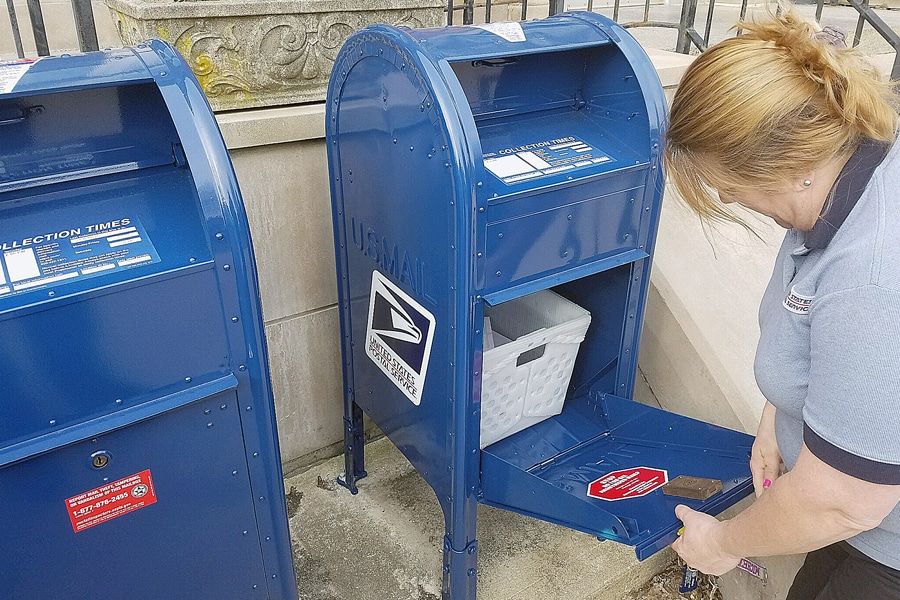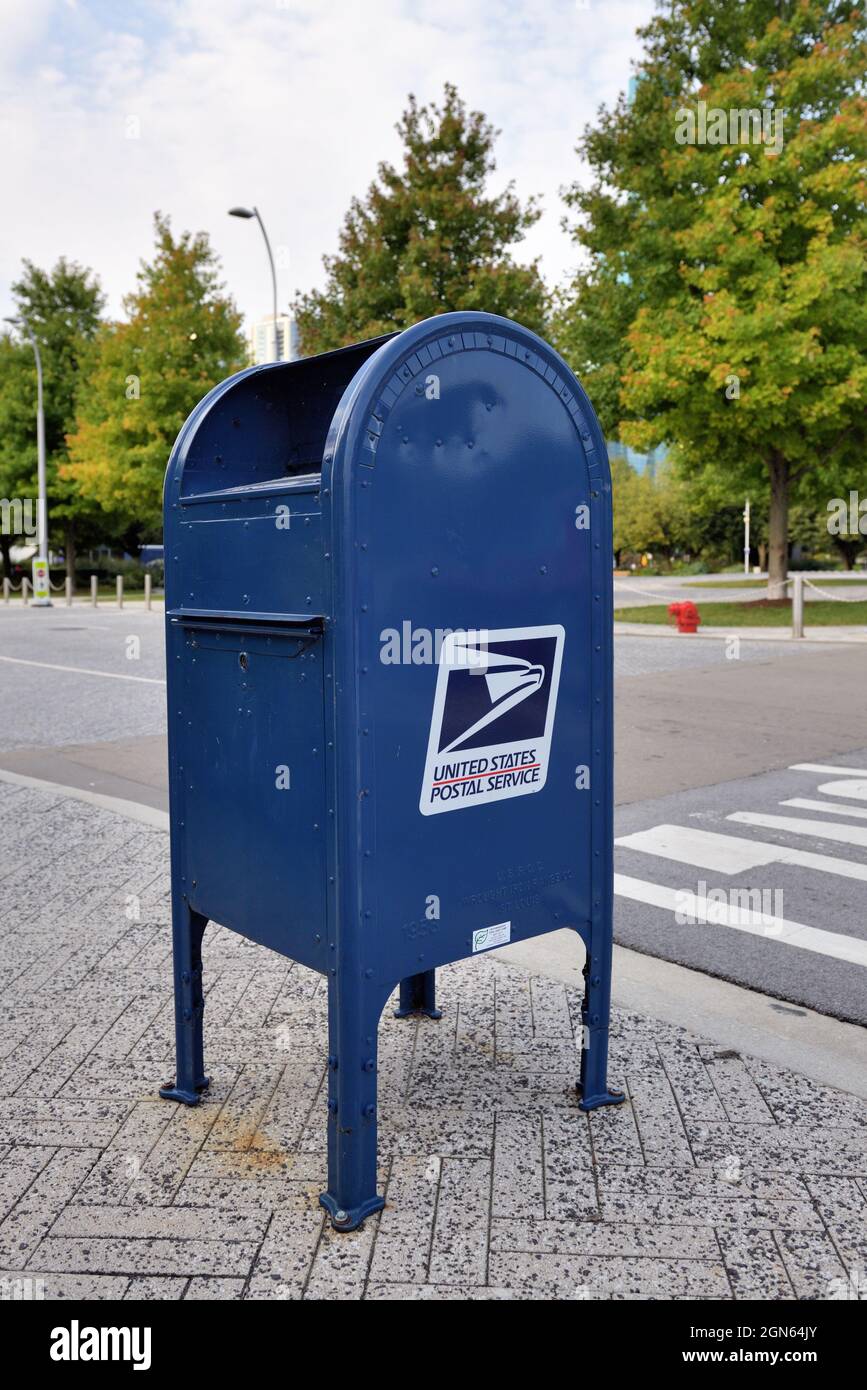USPS Collection Box Guide: What You Need To Know & Where To Find Them
Are you tired of making that trek to the post office just to drop off a letter or a package? The United States Postal Service (USPS) collection boxes, often overlooked, offer a convenient and efficient solution for your mailing needs, saving you valuable time and effort.
These ubiquitous blue boxes, dotting the American landscape, represent more than just receptacles for outgoing mail; they are an integral part of the postal infrastructure. Officially termed "collection boxes," they serve as designated drop-off points for letters, postcards, and even small packages. The convenience they offer is undeniable, allowing customers to bypass the potential queues at post office counters and streamline their mailing process. But beyond their obvious convenience, understanding the specifics of these boxes what can be deposited, where they are located, and the regulations that govern their use is crucial to maximizing their utility and ensuring your mail reaches its destination promptly and without issue.
Let's delve deeper into the world of USPS collection boxes, examining their functionality, the rules that govern their use, and how they contribute to the efficient operation of the postal service. These boxes are a key component of the USPSs network, and understanding how they work is essential for anyone who regularly sends mail.
USPS Collection Box
The USPS maintains a vast network of collection boxes across the nation, with an estimated 140,000 boxes available for public use. These boxes come in various forms, including the familiar blue freestanding boxes, as well as those incorporated into post office facilities. The placement of these boxes is strategic, designed to offer maximum accessibility to the public. You'll find them in areas with high foot traffic, such as busy commercial districts, residential neighborhoods, and near post office locations. This widespread availability ensures that mailers have easy access to a convenient method for sending out their correspondence. Often, you will find them in larger cities like Denver, San Antonio, or Columbus.
The primary function of a collection box is to accept outgoing mail and packages that meet certain size and weight limitations. The USPS uses a clear system for determining what is acceptable to deposit, along with corresponding regulations on proper postage. This is how the collection box works. Mail is deposited into the box, and the USPS collects it at the scheduled pickup times. These pickup times are printed on the label affixed to each collection box.
Beyond their essential purpose, collection boxes provide a practical benefit to mailers. They provide a convenient alternative to visiting a post office, saving time and reducing potential hassle. The availability of drop-off points throughout cities and towns makes it easy for individuals and businesses to stay on top of their mailing. Whether it's sending a bill payment, a birthday card, or an important document, these collection boxes are valuable tools that simplify the mailing process.
However, it's essential to understand the rules governing collection boxes to ensure your mail is processed correctly and efficiently. The USPS outlines specific guidelines concerning the types of items that can be deposited in these boxes. These guidelines focus on size, weight, and adherence to postage requirements. Failure to adhere to these regulations can result in delays, or even the return of your mail. It is advisable to check the posted restrictions before depositing items, and if in doubt, to seek assistance from a post office employee.
To better grasp the details of using collection boxes, let's break down some crucial aspects. First, let's consider the different types of mail and packages accepted. Then, we'll explore what is prohibited to be dropped in those boxes. Finally, we'll delve into the best practices that contribute to ensuring smooth and timely mail delivery.
What Can Be Deposited?
Collection boxes are primarily designed for standard mail items such as letters, postcards, and smaller packages. Items must adhere to size and weight restrictions. Generally, envelopes and flat mail are acceptable, as are packages that can be easily inserted through the mail slot. The dimensions of the mail slot vary, so it is important to consider the size of the box when determining if your package is the right fit.
In addition to standard mail, many collection boxes accept packages that meet certain criteria. Packages must comply with weight and size guidelines. The precise limits are specified on the collection box or available at the post office. Be aware that oversized or overweight packages may require special handling and should be taken directly to a post office counter.
What is NOT Allowed?
Certain items are explicitly prohibited from being deposited in collection boxes. The goal is to ensure the safety of postal workers, protect the integrity of the mail system, and comply with legal regulations.
Prohibited Items:
- Hazardous Materials: Explosives, flammable liquids, and other hazardous materials are strictly prohibited due to the risk they pose to postal workers and the potential for accidents during transport.
- Restricted Substances: Illegal drugs, firearms (unless permitted under strict regulations), and other restricted items are also not permitted.
- Oversized Packages: Packages that exceed the collection box's size or weight restrictions. These items typically require special handling at a post office.
- Items Requiring Customs Forms: International mail requiring customs declarations and forms. These documents need to be processed at a post office.
- Cash or Currency: Mailing cash or currency is generally not permitted. Using money orders or other secure payment methods is a better option.
Depositing prohibited items into collection boxes can have significant consequences, including mail delays, package confiscation, and possible legal action, depending on the item's nature and the severity of the violation.
Rules and Regulations
The USPS adheres to several specific rules regarding collection box usage. These regulations cover various aspects, including size, weight, and postage requirements. Understanding and following these rules is essential to ensure your mail reaches its destination successfully. A violation of these rules may result in delays, additional postage charges, or even the return of your mail.
Size and Weight Limits: Collection boxes have size and weight limitations to allow for the smooth and effective processing of mail. The precise limits depend on the collection box, but they are clearly posted on the box or available at the post office. Do not overfill these boxes.
Postage: Correct postage is mandatory for all mail items deposited in collection boxes. Insufficient postage can result in the mail being returned to the sender, delayed, or the recipient being required to pay additional postage. Always be sure to affix enough postage.
Sealing: Always properly seal your mail. Unsealed letters and packages can be damaged or lost during transit. Proper sealing also ensures that no contents can be accidentally revealed to others.
Address: Provide a complete and legible address. Make sure your return address is printed clearly, as well as the destination address. Include the correct zip code for both the sender and the recipient.
Package Preparation: Ensure that packages are properly packaged to prevent damage during transit. It is best to use sturdy boxes and appropriate packing materials. Make sure to use packing tape to seal your package securely.
Pickup Times and Locations
The pickup times for collection boxes are clearly posted on the box label. These times may vary depending on the location. It is advisable to be aware of the schedule when planning your mail drop-offs, to ensure your mail is picked up in a timely manner. Mail placed after the posted collection time will be collected on the next business day.
The locations of collection boxes are strategically placed across the country for convenient access. They are generally found in areas with high foot traffic. The USPS provides an online tool, available on its official website, to help customers locate collection boxes near them. This online locator is a useful resource that can help mailers find the closest, most convenient location for their mailing needs.
Tips for Using Collection Boxes
To streamline the mailing process and ensure your mail reaches its destination, consider the following tips for using collection boxes:
- Verify Postage: Always ensure that your mail has sufficient postage. Weigh your mail and use the USPS postage rate calculator to determine the correct amount.
- Proper Packaging: Properly package your items, especially packages, to prevent damage during transit. Use appropriate packing materials and sturdy boxes.
- Complete Addressing: Clearly print the recipient's address, including the zip code, and your return address on each item.
- Respect Pickup Times: Deposit your mail before the collection time posted on the box label to ensure timely processing.
- Review Restrictions: Before depositing mail, verify that it complies with the restrictions regarding hazardous materials, restricted substances, and package size.
The USPS collection boxes are valuable tools for anyone who needs to mail letters, postcards, or small packages. By understanding their purpose, the rules, and following best practices, customers can take advantage of their convenience, save time, and ensure their mail is delivered on time.



